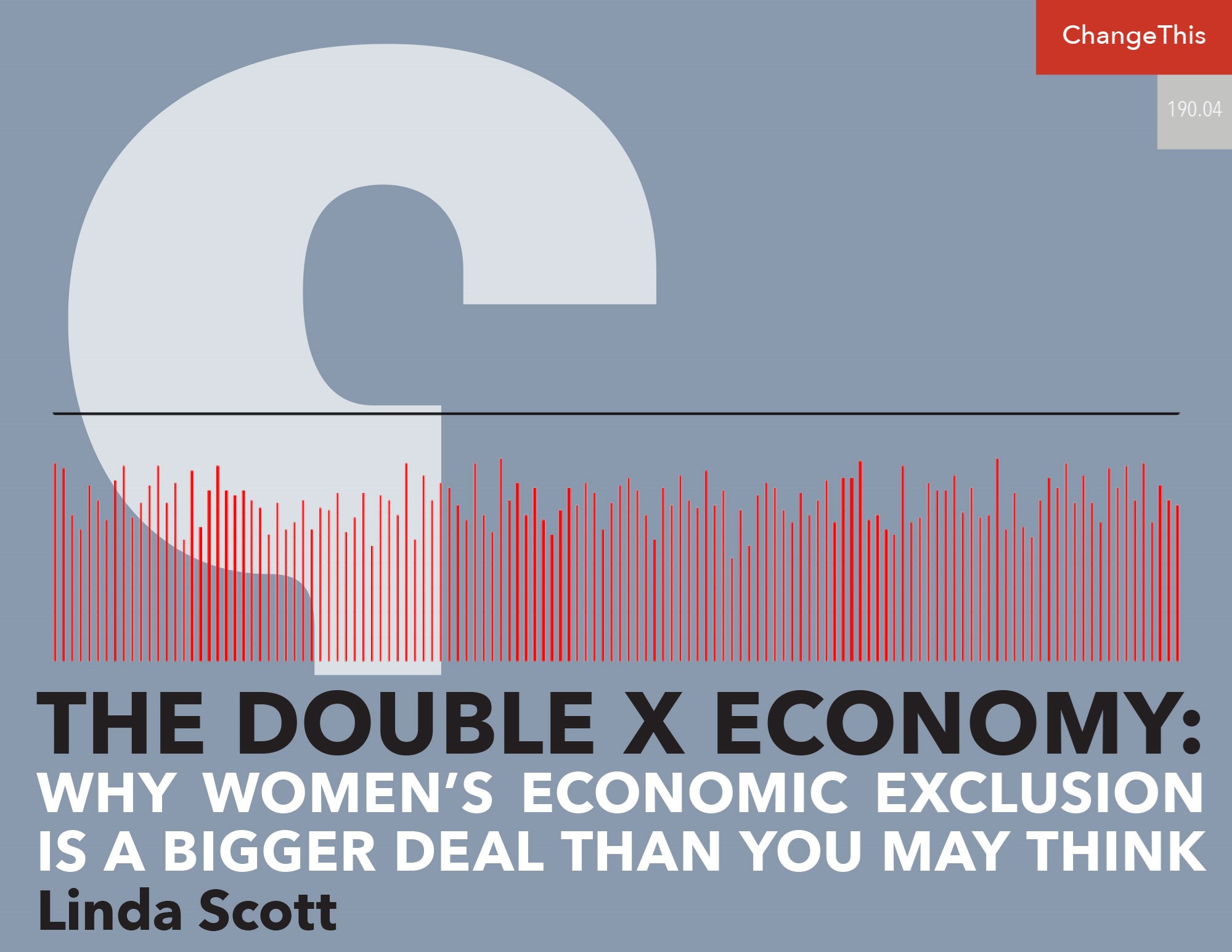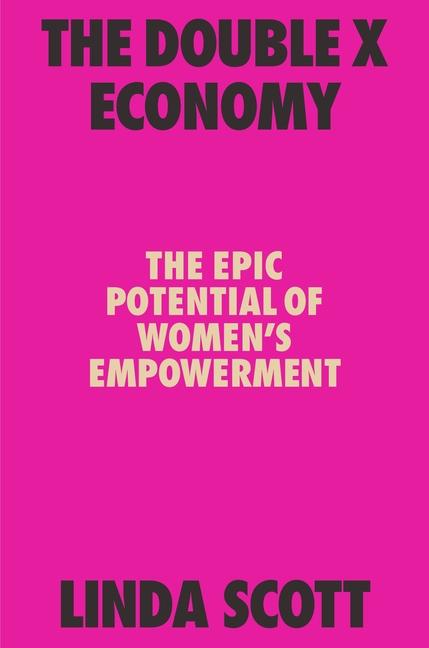The Double X Economy: Why Women’s Economic Exclusion is a Bigger Deal Than You May Think
July 29, 2020
Despite accounting for half the species, half the national income, and half the food supply, women are nevertheless treated as bit players by economists and policy makers. […] The opportunity cost of excluding the Double X Economy is always steep.
A distinctive pattern of economic inequality marks the female population of every nation, each with the same mechanisms holding the disadvantages in place.
For decades, the conventional wisdom held that a nation’s gender situation was a function of their culture and therefore unique, but an unparalleled influx of data since 2005 has revealed that all countries share the barriers to women’s economic inclusion—and these constraints reach well beyond work and salary to encompass property ownership, capital, credit, and markets.
These economic impediments form a shadow economy unique to females: I call it “the Double X Economy.” Like any other economy, this shadow system reaches into every economic domain, from investment to charity, and is not merely a labor force. Like the gig economy or the underground economy, the Double X Economy is an identifiable part of the world system, but not completely self-contained. Because of the constraints placed on it, the Double X Economy has particular ways of doing business, as well as typical products, services, and jobs.
Because of an absence of data and a blinkered way of thinking about our exchange systems, the Double X Economy has gone unnoticed. The smallest unit of data we usually record is the household, in which women’s earnings are typically attributed to a male head. Economic measurement focuses on money, but much of women’s economic contribution, such as their farm labor, goes uncompensated. For these two reasons alone, our systems do not pick up women’s economic activity most of the time.
To make matters worse, institutions from universities to banks to governments have not generally collected or analyzed data by gender. The absence of consistent gender data has meant that comparing the welfare of women here with those there, or even now with then, has been impossible to do systematically—until now.
The deep contempt economists hold for women has also been an impediment. Economics as a discipline has an outsize impact on society because of its role in a dvising governments. “If systemic gender bias skews the way the field looks at things,” said The Economist, “that has implications for the policymakers and others looking to academic economists for analysis, advice or indeed wisdom.” Economics professors’ bias against real women translates into a negative attitude toward the topic of women’s economics, making it hard for the Double X Economy to win a place on the global agenda.
The philosophy that underpins “economics-as-we-know-it” also presents a formidable barrier. Its first principle is that the economy is built on the collective actions of rational, informed individuals who act independently to make free choices in their own interest; these aggregate into the optimal outcomes for everyone—as if guided by Adam Smith’s famous “invisible hand.”
Women, as a class, have severely constrained choices, have important information actively withheld from them, and are punished for showing anything like self-interest. Indeed, women can seldom act independently; rather, they are often coerced into acting irrationally—that is, against their own best interests. Right now, that fact is being illustrated on a world scale as the pandemic forces women out of the economy and back into the home. Our leaders are largely ignoring women’s plight; the result is involuntary economic withdrawal.
Women contend with economic exclusion, not merely unequal economic outcomes—a circumstance that the dismal science doesn’t even have the tools to conceptualize. The prevailing economic philosophy offers an explanation as bigoted as it is implausible: (a) women are inferior to men when it comes to any kind of economic engagement or (b) they have chosen to put themselves in an underprivileged position in every country, every occupation, and every domain in the world economy.
The unfortunate truth is that, right at its roots, the global market’s economic philosophy can’t address half the world’s people.
Because of this intransigence in academia, the data analysis that revealed the Double X Economy’s profile has been done by gender groups within large international agencies, not universities. Major institutions like the United Nations Development Programme and the World Economic Forum began comparing measures of women’s status (education, employment, leadership, health, legal rights) with the performance data of national economies. Where gender equality was high, national incomes and living standards were also high, but where gender equality was low, countries were trapped in poverty and conflict.
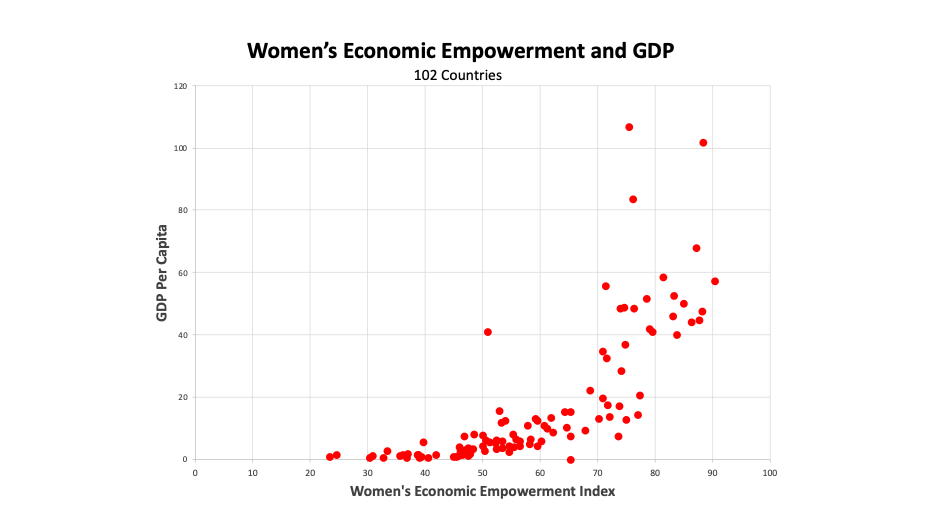
Each dot represents a country’s Women’s Economic Opportunity Index score as related to GDP. All countries for which the data was available are included. The upward-right direction of the dots indicates that more economic freedom for women corresponds positively to growth. Sources: World Bank Database for GDP at purchasing power parity; Economist Intelligence Unit for the Women’s Economic Opportunity Index.
At first, people said, “Oh, well, in the poor countries, they have to worry about survival, so it is necessary for the men to be dominant. The rich nations are more comfortable, so they can afford to let the women have more freedom.” But there was never any evidence that male dominance is necessary for survival. In fact, we can now say, with considerable evidentiary support, that excessive male dominance is a destabilizing factor that reduces the chances for survival, especially because it so often leads to conflict.
In the poorest and most fragile countries, indicators of gender equality are lowest and the effects of women’s economic exclusion are devastating, perpetuating poverty and contributing to violence of all kinds, as well as increasing hunger, denying children’s needs, wasting resources, and feeding slavery. Where women have no freedoms, everyone suffers.
Enabling women economically has become a proven strategy in the fight against suffering. “As study after study has taught us, there is no tool for development more effective than the empowerment of women,” wrote Kofi Annan, Secretary-General of the United Nations, in the opening of UNICEF’s The State of the World’s Children report in 2007. “No other policy is as likely to raise economic productivity or to reduce child and maternal mortality. No other policy is as sure to improve nutrition and promote health,” adding that, “No other policy is as powerful in increasing the chances of education for the next generation.”
Despite the known capability of economically empowered women to alleviate distress in poor countries, only the thinnest slice of international aid is aimed at females.
In 2006, the World Economic Forum took the stance that including women equally in national economies spurs growth and that, without fair inclusion of women, countries stagnate. The solution for poor countries, they advised, was to embrace gender equality. A mountain of data has since converged to show gender equality positively influencing country wealth and overall well-being—while also showing the negative influences of male economic monopoly.
The world-changing lesson implied: it’s not that the rich nations could afford to set their women free, but that setting the women free made them rich.
The numbers show that the Double X Economy is huge; only resolute blindness causes economists to miss it. To illustrate, if the Double X Economy in the United States were its own nation, that country’s economy would be big enough to join the G7.
Women already produce roughly 40 percent of global GDP, and their contribution will soon match that of men. Women produce almost 50 percent of worldwide agricultural output.
Despite accounting for half the species, half the national income, and half the food supply, women are nevertheless treated as bit players by economists and policy makers.
Look again at the pandemic situation. Blinkered economic planners and politicians are foolishly ignoring the distinctive disadvantages suffered by a major economic resource— women. Think about this: if, in normal times, American women produce 40% of GDP and constitute the majority of the workforce, then why would you leave them out of a recovery plan?
The opportunity cost of excluding the Double X Economy is always steep. Even before the pandemic, the rich nations’ failure to invest in childcare forced millions of mothers to work part-time or quit completely, leaving billions in GDP on the table. The World Bank estimates that, because of unequal pay, global wealth shrinks US$160 trillion every year, while penalizing the Double X Economy for some of its most important economic work— the cultivation of human capital.
An educated, healthy population is the most valuable resource a modern economy can have, but we have come to see children as private luxuries rather than public assets. Each rising generation is crucial support for every cohort ahead of them—we all must rely on other people’s children to be our firefighters, police, and construction crews, not to mention teachers, doctors, musicians, and librarians. Replenishment of the labor supply also keeps the tax base up, which helps everyone who relies on public services (that is, all of us).
The Double X Economy lays the groundwork for a positive future by its judicious spending on families and communities. Though the prevailing wisdom everywhere is that women are frivolous consumers who blow their money on clothes and cosmetics, while men are rational and responsible economic beings, evidence reveals this belief to be straight-out gender ideology. Men, as a group, often choose to spend money on their own indulgences, rather than sharing it with their families, even prioritizing expenditures on vices such as alcohol, tobacco, gambling, prostitution, and guns above their children’s education. By contrast, women, as a group, spend first on their families, especially children, and communities.
A report by Goldman Sachs’s Global Markets Institute illustrates the importance of this phenomenon. Goldman Sachs argued that the BRIC and “Next 11” countries must achieve gender equality in order to create a middle class, which every market economy needs for stability. Their proof was that women spending money on improving household welfare—nutrition, education, medical care, clothing, childcare, and household durables—is what builds the middle class.
Again the pandemic reveals our blindness. Women are the primary buyers of goods in practically every category: American women control 70% to 80% of consumer spending. And, more than 40% of women in the US are the primary breadwinners for their families. The US needs consumer spending to propel recovery. That won’t happen without the women.
Despite women’s centrality to our material well-being, the Double X Economy is consistently undervalued because a worldwide conviction persists that females simply deserve less. You can see it in the Wage Equality for Similar Work data collected each year by the World Economic Forum. Managers in 132 nations are asked, “In your country, for similar work, to what extent are wages for women equal to those of men?” The sum of their answers is not a direct report of actual pay, but an estimate of what normative practice is in that country—what women are customarily and, implicitly, fairly paid. There is no country on earth where the custom is to pay the sexes equally for the same work.
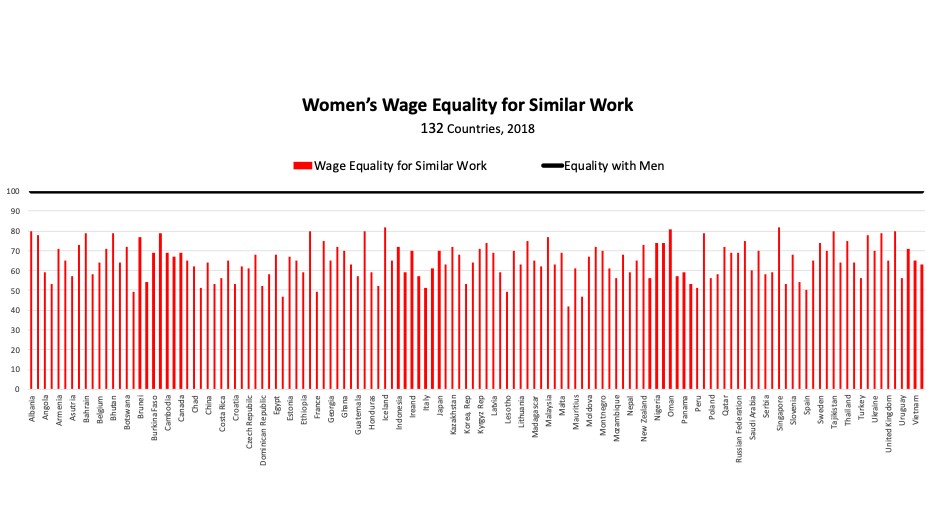
The Wage Equality for Similar Work measure is expressed as the percentage of men’s pay that women are paid for the same or similar work. The black bar marks the level at which women would be paid equally to men. You can easily see that women are not customarily paid equally for the same work in any country in the world. Countries are shown alphabetically starting with Albania and ending with Venezuela. Source: World Economic Forum, The Global Gender Gap Report, 2018
In every type of work in every sector, every occupation, and every country, women are paid less than men; every source of pay information, collected by every method, ends in this conclusion. Only through dishonest manipulation of the data can you show any other finding.
Unfortunately, plenty of apologists for male dominance are willing to jiggle their stats so they can push out a meme claiming that “the gender pay gap is a fiction.” They massage the numbers to control for influences that are clearly gendered, especially the impact of housework and childcare on women’s careers, then announce triumphantly there is no such thing as sex discrimination.
The statistical sleight of hand at work here is made clearer by analogy. African-American men are paid less, on average, than white males are. Imagine someone takes the data set on male pay and controls for variables like living in a disadvantaged urban zip code or having been unemployed recently or having been arrested. After all those factors have been thrown out, the white men and black men are paid the same.
“There is no racial discrimination in America! Black men would be paid the same if they acted more like whites!,” the analyst announces. But their conclusion is not valid because the variables eliminated are each either a reflection of racial discrimination or a means by which racial discrimination is accomplished.
We would be very suspicious of the motives behind an analysis like that. We should be equally suspicious when the data set is women.
In truth, the crux of the Double X Economy’s plight is its burden of servitude; so-called “obligations” at home penalize women in the workplace and increase their personal economic risk. Women’s “responsibilities” in the home—real or assumed—gradually result in lower pay and less advancement at work. Because of a lifetime’s accumulation of economic disadvantages, the typical woman’s pension or retirement account will be significantly smaller than a man’s, so women are more likely to be poor in old age, becoming a burden to their families and their governments.
One reason women are so disadvantaged at work is that the companies employing them have been owned, not just led, by men. Why is that? The answer is that the Double X Economy suffers from a severe capital disadvantage, one with roots more than a thousand years old.
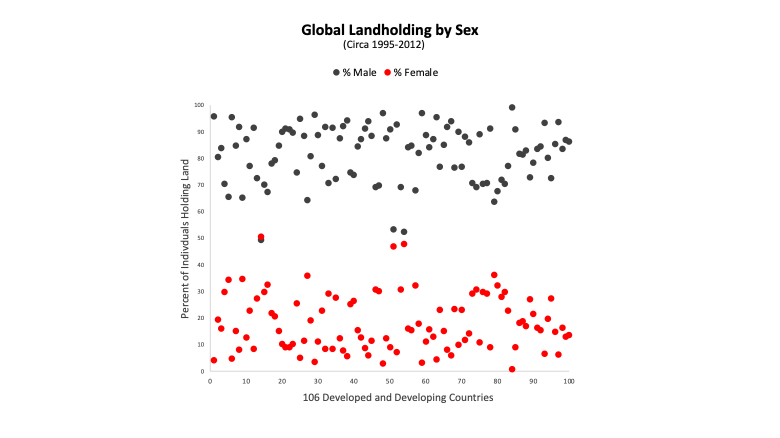
This scatterplot illustrates the vast gap between male and female ownership of land. The black dots show that 70 to 90 percent of landholders in most countries, rich and poor, are men. Countries are shown alphabetically, starting with Algeria and ending with Zambia. Source: Food and Agriculture Organization, “Gender and Land Rights Database.”
Land has been world society’s main store of wealth since the invention of agriculture. Women have nearly always been prohibited from owning it or controlling it. These restrictions cannot be brushed off as a thing of the past: the last legal prohibition against American females owning and controlling land (or other capital assets) was declared unconstitutional in 1982. You can still see the impact today: American women are only 13.7% of landowners, 5 percentage points lower than the global average.
Men now own more than 80% of the world’s land. That corner on wealth, in place since at least the Code of Hammurabi, has rolled up into a near-monopoly on capital today.
Another reason women hold less wealth is that they haven’t had the means to keep money safely and privately, nor the ability to invest it. The Double X Economy has been barred from the financial system since it was invented. Only in the 1970s did women in the West win the right to have bank accounts and credit in their own names. Today, women in the developing world push for those same rights.
Let’s be clear. There have always been exceptions: individuals, especially aristocrats, have sometimes been able to get around these restrictions. But their stories only prove the rule that most women were not. A few times in history women did have property rights, the Ottoman Empire, for instance, or the Song dynasty. Unfortunately, all these reforms were temporary. Even after hundreds of years, women would suddenly lose their economic rights—and all other rights with them.
That’s why the specter raised by The Handmaid’s Tale—where the economic rights were revoked first, to make the assumption of reproductive rights easier—should be taken seriously. Today’s rise in authoritarianism poses an ominous threat to women’s freedoms. There is no reason whatsoever to think recent gains are permanent.
In a world given to congratulating itself on open exchange and free trade, the Double X Economy routinely struggles against gender-based barriers to market entry. Guilds, unions, cooperatives, and marketing boards historically have barred women in the West, something that is still true in other parts of the world.
The exclusion of women is nearly total at the level of global exchange, where the markets and profits are very large. Very few women participate in international trade or win large institutional sales contracts, both areas of the economy in which men control a staggering 99 percent of business. According to the International Monetary Fund, introducing better gender balance to global trade would be beneficial, because such diversity makes economies more resistant to downturns and more prone to innovation. Economists in policy still refuse to consider reforms because, they say, “trade” is objective and should not address “political” issues like gender. Apparently, they think allowing the male monopoly on trade to continue is not a political act.
The Double X Economy has always had limited access to information. Since the invention of writing and mathematics, societies have blocked women’s education. Schooling for girls—where it existed at all—focused on household arts, leaving issues of law, medicine, finance, government, and management to boys. Women were not admitted to universities until the nineteenth century. Some disciplines, usually science and mathematics, were off-limits to them until after World War II.
Today, the world’s women are approaching eq
uality to men in education for the first time in history; indeed, in the developed nations, they are already educated to an equal or greater degree.
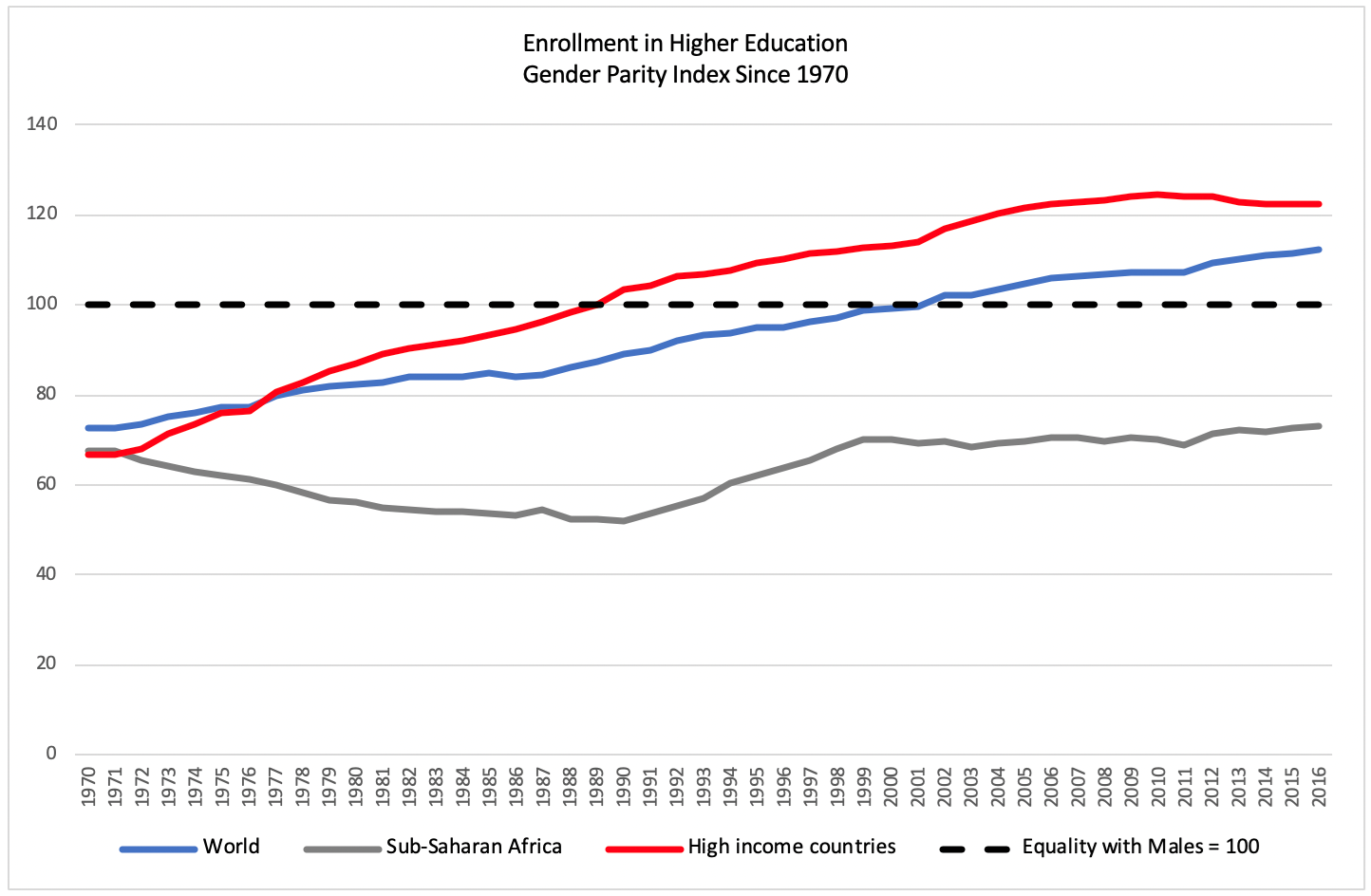
In the graph above, the dashed black line indicates where equality with men would be. Females in high-income countries passed the equality mark around 1990. The world total shows females passing equality in about 2000. The bottom line represents sub-Saharan Africa, the only region where women do not now enroll in higher education at a rate equal to or higher than men. Source: World Bank Database, accessed July 17, 2018.
Across the G7 countries, the average woman is now more likely to have completed higher education than the average man and younger women are enrolled in higher education significantly more often. In a growing number of countries, such as the US and the UK, women are also the majority of science graduates—that’s because you can only make men the majority in STEM if you eliminate all the life sciences from your definition.
Think about what goes into educating these women. Family savings. Government loans and scholarships. Gifts to universities. Taxpayer contributions. Nations are deploying significant resources to educate women, yet they consistently underutilize female talent.
Ironically, the rich countries face the imminent prospect of slow or even zero growth, as well as a skills shortage, but they are still throwing some of their best people under the bus.
The Double X Economy may well be the world’s most wantonly wasted resource.
The power of gender equality to reduce costly suffering is also important. For instance, the slave trade is bigger today than ever in history and 71% of the victims are female. Economic vulnerability is what causes females to become human trafficking victims, a phenomenon long visible in the poor nations, but dramatically exemplified by Jeffrey Epstein’s recruiting methods.
Domestic violence, a phenomenon closely linked to economic gender inequality within communities, is extremely expensive for nations. Over and above the inestimable price of human suffering, there are the police calls, emergency room visits, women’s shelters, lost work days, and psychological counseling, which all have price tags that can be used to calculate the aggregate costs.
The Copenhagen Consensus Center estimates that “intimate partner violence against women” costs the global economy US$4.4 trillion annually, or 5.2 percent of GDP. That’s about the same percentage most nations spend on primary education, and thirty times what the world spends on international aid.
Globally, this phenomenon is dramatically skewed, with higher levels of intimate partner violence in the poor, conflicted countries where gender equality is lowest: in Sweden, for instance, 24% of women have experienced violence at home; in Afghanistan, it’s 87%. In fact, violence of all kinds—including civil conflict and war—is lower in the nations with high gender equality.
Despite the regional variations, however, the Double X Economy suffers from hostility in workplaces and markets all over the world. Sexual predators exist in factories and high-tech companies, just as they do in Hollywood. Supervisors stalk female agricultural workers, attacking them in open fields where they can’t be seen or heard. Venture capitalists try fondling women seeking investment and then refuse to support them if they do not comply. Commuter violence puts women in danger every day. There is no industry and no country where women are safe.
The Double X Economy is also consistently undercut by everyday bigotry. Employers avoid confronting this reality, instead hiding behind flashy but insincere “diversity programs” and euphemizing bigotry as “unconscious bias.” Unconscious bias is a specific cognitive phenomenon in which well-established habits of perception produce shortcuts in the brain’s processing. Those shortcuts do some times result in unconscious acts of unfairness, but the reason is that the cerebral connections were already imprinted by years of learning that women are less worthy. The term is now widely used, however, as a blame-free smoke screen for anyone committing discrimination, whether unconscious or overt, to hide behind.
Labeling all discrimination “unconscious bias” only provides cover for those who are consciously biased to continue in unrepentant acts of prejudice.
A particularly sick manifestation of overt bigotry is the too-common assertion that women are not good at math, mostly because their brains are inferior. This falsehood is particularly rife in the tech and finance industries, both also industries where sexual harassment is common.
Current neuroscience has flatly rejected the idea that brains differ by sex. Performance statistics further undermine the claim that “women can’t do math.” When all the available math test data are aggregated and analyzed, the differences don’t vary by sex, but by things like parental employment and postal code.
Math performance also varies by national gender equality, just as the incidence of violence does. Where women are more equal, math performance is high; conversely, where the gender equality is low, math performance is, too. These performance differences could not occur if mathematical ability were a function of biology.
The Double X Economy brings an ethic of leadership that could quell the worst impulses of our economic system. Gender balance makes workplaces friendlier and fairer, while also spurring superior business outcomes. Governments and the public also benefit from diverse corporate leadership because the improved transparency and risk reduction that comes from women’s presence at the top protects the stability of the overall economy.
Women are economically disadvantaged in every country in the world, a phenomenon that not only holds back prosperity and peace, but perpetuates suffering on a global scale. Because females are unequal in every group, policies to better include women economically would benefit all segments of the world population, including the most marginalized people.
Never in history have we had such a vivid blueprint for eliminating suffering, achieving justice, and ensuring peace. Never before has it been possible to troubleshoot one problem and solve so many others. What we would achieve is worth every effort we can make, every new tool we can invent, and any funds we have to invest. Now is the time for women and men to come together and set the Double X Economy free.
ABOUT THE AUTHOR
Linda Scott is the Emeritus DP World Professor of Entrepreneurship and Innovation at the University of Oxford and a Senior Consulting Fellow at the Royal Institute for International Affairs. She founded, and is now the senior adviser to, the Global Business Coalition for Women’s Economic Empowerment and was selected as one of the top 25 Global Thinkers by Prospect in 2015. Scott works with multinational corporations, international agencies, national governments, and global NGOs designing and testing programs to better include women in the world economy.


